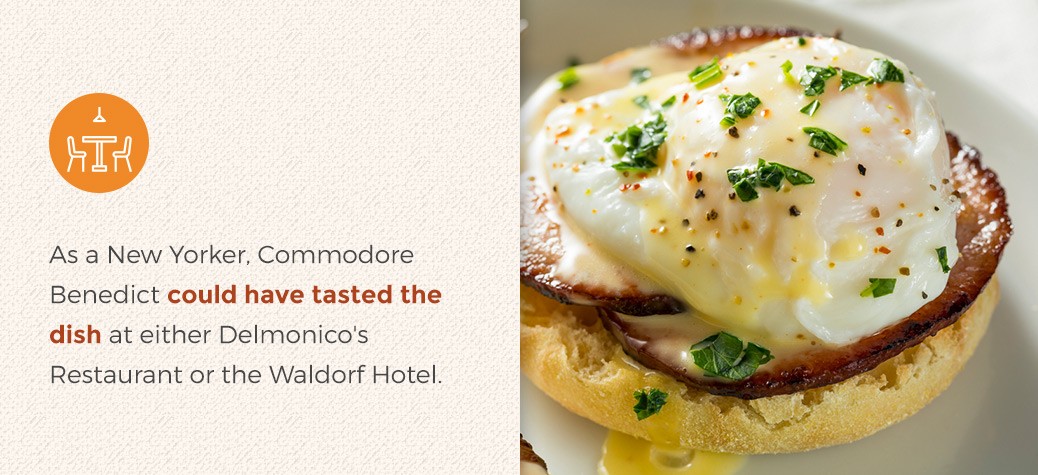The History of Eggs Benedict
Posted on: August 2nd 2019

While the presence of eggs Benedict on brunch menus is almost inevitable, the origins of this dish are not. Many historians dispute where this hearty breakfast topped with creamy hollandaise sauce originated. The suspects in this whodunit mystery include a regular couple at Delmonico’s, a yachtsman, and a drunk Wall Street broker. All three were wealthy New Yorkers, so history seems to tell exactly where the dish originated. Who and when are less clear.
Now, it’s time for you to be the detective and examine the evidence to decide who you think created this breakfast staple. Was it the Delmonico’s patrons, the Commodore, or the inebriated broker? The stories behind these theories include many twists and turns that obscure the truth.
The First Theory: Delmonico’s

While Delmonico’s opened in 1837, the restaurant wouldn’t play a part in the history of eggs Benedict until years later. For almost two hundred years, New Yorkers have associated Delmonico’s Restaurant with fine dining. It was the first establishment to offer this service in the country and remains a pillar of the eating community in the city today.
In fact, many Americans weren’t familiar with the Frenchword until the Delmonico brothers chose it for their dining establishment. Women could eat alone without male companions, a break from contemporary mores. Additionally, this restaurant was the first American eatery to use tablecloths in their dining area. It’s kitchen also created many famous recipes that remain popular today — lobster Newberg, baked Alaska, and chicken a la Keene. These innovations have made Delmonico’s the mythic source of many other dishes, including eggs Benedict.
Regular customers at restaurants often get their customized dishes on the menu. This method was allegedly how eggs Benedict made its way onto American plates. A frequent diner at the establishment, Mrs. LeGrand Benedict, came so often that she tired of the existing menu offerings. Here is where the story begins to deviate from a single path.
Some sources claim Chef Charles Ranhofer created the dish independently of any suggestions from Mrs. Benedict other than “something different.” Another story claims Mrs. Benedict herself said she wanted poached eggs, ham, and hollandaise on an English muffin with truffles. In this version, the question remains of how she got a craving for such a particular combination. Had she had it elsewhere? Perhaps at New York’s Waldorf Hotel, another possible contender for the first location of the recipe.
Regardless of who outlined the ingredients for the dish, Chef Ranhofer published the recipe as eggs a la Benedick in a cookbook published in 1894, The Epicurean. The fare in The Epicurean did not read like modern recipes with exact measurements. Instead, the directions for eggs a la Benedick created guidelines for making the dish. This recipe called for a halved English muffins lightly toasted and topped with ham, poached eggs, and hollandaise sauce. These directions create almost the same as the modern dish, which often substitutes Canadian bacon for ham.

Having the recipe published in a verifiable source gives the most persuasive evidence for the dish arriving on the American dining scene in 1894. While Ranhofer published the recipe in 1894, the food could easily have come into being much earlier than that. Debate rears its head again in the time of the actual invention of the dish.
The stories, though, place Mrs. Benedict at the restaurant in the 1860s, though Ranhofer did not publish the recipe until 1894. She could not have been Mrs. Benedict at the time because her husband was born in 1855 and she in 1856. Other sources put the couple at Delmonico’s during the more likely decade of the 1890s. This later time makes more sense because the recipe would be fresh in Chef Ranhofer’s mind to add his cookbook. Because the exact timing of the Benedicts’ visit to Delmonico’s restaurant remains unknown, pinning the dish’s creation on them becomes difficult.
If the stories surrounding this origin cannot agree on the decade of the Benedicts’ famed dinner, can they genuinely attribute the creation of eggs Benedict to Delmonico’s Restaurant?
The Second Theory: Commodore E.C. Benedict
The second theory associated with the history of eggs Benedict takes the recipe’s origin story to the other side of the Atlantic in the year 1967. The New York Times food editor Craig Claiborne received an unexpected letter from France written by American Edward P. Montgomery. Montgomery claimed his maternal uncle befriended Commodore E.C. Benedict, who allegedly created the recipe.
Commodore E.C. Benedict lived in New York where he was a yachtsman and banker. Even without attributing the creation of eggs Benedict to him, the Commodore had a full and famed life. He owned 80 acres of waterfront land in Greenwich, Connecticut. That location was where his estate, Indian Harbor, was constructed. His vast wealth came from decades on Wall Street and his creation of the Gold Exchange Bank.
In 1893, Commodore Benedict, a close friend of President Grover Cleveland, offered the politician a safe, private refuge for surgery. President Cleveland’s jaw surgery to remove a cancerous growth proved successful. Even more surprising was the location of the operation, aboard Benedict’s yacht the Oneida.
In addition to these later-life successes, Benedict had an eventful youth. He started as a Wall Street clerk at only 15 years old, but when not in the office, he loved the sea, favoring trips through “strange waters.” Even with his far-flung trips, he only shipwrecked once.
A tough businessperson and a yachting fanatic, could Commodore Benedict have created the dish that shares his name? The meal attributed to the Commodore included ingredients less common in today’s iterations of the recipe, toast and ham. However, these parts could have been based on availability or personal taste. The hollandaise sauce, though, was different from the smooth, creamy topping used today. It included ham and hot, hard-cooked eggs in the sauce.

His recipe for eggs Benedict passed through to Montgomery’s family, according to the letter, which also included the recipe. The Commodore died at age 86 in 1920, so the dish’s creation could have occurred in the 19th century. Whether it happened before or after the other possible origins remains unclear.
As a New Yorker, Commodore Benedict could have tasted the dish at either Delmonico’s Restaurant or the Waldorf Hotel, the two other suspects in this mystery. Perhaps the differences in Benedict’s version and modern recipes came from the Commodore replicating the dish at his estate. Without knowing the exact year, he wrote down his version of the recipe. It’s impossible to tell if he first created it or came after another inventor.
Several people objected after The New York Times published the letter to its food editor in 1967 suggesting Commodore Benedict created the dish. One of those in the opposition was Mabel C. Butler, who wrote outlining the tale of Mrs. LeGrand Benedict inventing the dish at Delmonico’s. Hers was not the only voice of dissent, but it connects back to one of the three top suspects for the inventor of the dish.
While evidence supporting Commodore E.C. Benedict’s contribution to brunch is shaky, some people, like Edward Montgomery, support the theory that the Commodore added a tasty breakfast treat to his list of life’s accomplishments.
The Third Theory: The Waldorf Hotel

The third possible suspect in the history of eggs Benedict mystery is the luxurious Waldorf Hotel, but the creator of the dish was known more for his gadabout ways than for his riches.
The Waldorf Hotel today creates one location of the well-known Waldorf-Astoria, and the story originates with the wealthy Astor family. Two cousins of the family, John Jacob Astor IV and William Waldorf Astor, had an ongoing feud.
The latter held such animosity for the family and the United States that in 1893, he tore down his mansion and replaced it with a thirteen-story hotel named for him, the Waldorf. He uprooted his immediate family and left for England after that. His cousin’s four-story brownstone home stood in the shadow of the luxury hotel, a position the other Astor cousin refused to take quietly.
Two years later, in 1895, John Jacob Astor IV, repeated his cousin’s actions, though this time, he constructed a seventeen-story hotel to outdo his relative. John Jacob’s Astoria Hotel opened in 1897. The two cousins agreed to join the names and buildings of the hotels into the Waldorf-Astoria Hotel with the two towers connected by a single hallway called “Peacock Alley.” The original union included a hyphen today’s hotel name lacks. That Victorian iteration of the hotel fell to the wrecking ball in 1928, when developers tore it down to make room for the more modern Empire State Building.
The hotel’s name persists, however, as a second version of the hotel opened in 1931. This version of the hotel remains a favorite spot for celebrities and politicians. In fact, the presidential suite at the hotel has earned its name by hosting every sitting American president since Herbert Hoover.
Lemuel Benedict, a man from a wealthy family, did not hold up to his parents’ ideals of noblesse oblige. In fact, instead of becoming a staid businessman and marrying a woman of an equally prestigious family, he chose an opera singer for his partner.
During the day, Benedict, or “Lemmy” to his friends, worked as a Wall Street broker, as many of his class at the time did. However, after work, he strolled around town in a coonskin cap while brandishing a cane. Rumors hinted the cane held a hollow for a flask of alcohol.
Following a night of carousing in 1894, Lemmy drunkenly stumbled into the Waldorf Hotel. As anyone who has needed hearty sustenance after a night of partying, Lemmy requested the carby, protein-packed, creamy ingredients of what would later become eggs Benedict — buttered toast, poached eggs, bacon, and hollandaise.
The maître d’hôtel of the Waldorf Oscar Tschirsky adapted the recipe into the more familiar dish known today. He replaced the bacon with Canadian bacon and used English muffins instead of buttered toast. The meal shortly appeared on the menu at the Waldorf Hotel. Other recipes of renown attributed to Tschirsky, better known as “Oscar of the Waldorf,” include red velvet cake, Waldorf salad, and the martini.

Tschirsky’s role in the origination of eggs Benedict brings a new piece of evidence into the mix. His previous job at Delmonico’s Restaurant. Oscar of the Waldorf actually got his start at the hotel’s rival dining establishment, Delmonico’s in 1887.
Tschirsky’s rise to fame began as soon as he arrived in American. Within only three hours of stepping ashore in New York City, he got a job as a busboy at Hoffman House. After only six months, he rose from busboy to waiter, but he moved to Delmonico’s after that. There, in 1887, he learned about both the restaurant industry and the innate nature of people of the wealthy class. He found that great people also had simple needs.
Tschirsky himself reported wanting to work at the Waldorf Hotel from the time he saw the building’s construction. He already had a position at the hotel on opening day, March 13, 1893, only a year before Benedict’s famous visit. Historians report Tschirsky used a self-written letter of recommendation on Delmonico’s Restaurant’s stationery accompanied by eight pages of signatures from the prominent and well-to-do he met during his time at Delmonico’s.

Questions now arise of whether Tschirsky brought eggs Benedict from Delmonico’s Restaurant to the Waldorf Hotel of if the Lemmy Benedict inspired it at the hotel.
In 1978, Jack Benedict, a descendant of Lemmy, reacted to the suggestion that Mrs. LeGrand Benedict inspired the dish by opening his own restaurant, L.C. Benedict Restaurant and Tavern. Far from New York City, his eatery was in Winter Park, Colorado. In protest over the suggestion of the dish’s origination at Delmonico’s Restaurant, the Jack offered eggs Benedict with two options, both of which came from the Waldorf Hotel. Oscar’s way featured English muffins and Canadian bacon. Lemuel’s way came from the original dish Jack’s ancestor made, with bacon and buttered toast.
In further effort to promote the dish, Jack Benedict even pitched the idea of an eggs Benedict sandwich to McDonald’s. However, the fast-food giant was already at work developing the Egg McMuffin and did not have development time to devote to another, too similar, breakfast dish.
Despite Jack Benedict’s efforts, the creation of eggs Benedict, along with the origin of hollandaise sauce, continues to be disputed by historians and food lovers alike.
So, Who Invented Eggs Benedict?
With three stories, which sounds the most plausible? Look closely at the evidence. Which has the most substantial facts supporting it and the earliest creation date?
The facts supporting Commodore E.C. Benedict seem the weakest, a single letter from someone decades after the Commodore died. The exact date of the dish’s invention does not appear anywhere in the story, either. Compared to other recipes for the dish, which call for traditional hollandaise sauce, Commodore Benedict’s version changed the sauce from a buttery, creamy sauce with yolks to one that included hard eggs and ham.

The origins of hollandaise sauce started with a similar topping coming to France from the Huguenots. Initially, the sauce used eggs to thicken a butter-flavored sauce. The wealth of high-quality dairy, including butter and eggs, from the French town of Isigny-sur-Mer, gave the sauce its alternative name, Isigny sauce. Allegedly, the sauce did not change to hollandaise until World War I forced Holland to import butter into France.
As with other stories in culinary history, the term hollandaise likely did not appear after the first World War. Cooks knew of the term as early as the 1830s and recipes for sauces similar to hollandaise appeared in the 17th century. Francois Pierre de la Varenne penned a cookbook in 1651 titled The French Cook. One of the recipes in the book called for asparagus to have a topping of a yolk-bound sauce with butter, which La Varenne called fragrant sauce.
Since the sauce was so well-known by the late 19th century, a recipe for eggs Benedict that would change basic hollandaise seems the efforts of an amateur. If he invented a recipe, his version of eggs Benedict could be named something else, due to its fundamental differences in the sauce. While you cannot deny Commodore Benedict’s accomplishments in life, you can doubt his claim to the creation of eggs Benedict.
So, what about the rival restaurants — the Waldorf Hotel and Delmonico’s Restaurant? The Waldorf had the recipe on its regular menu, and Chef Ranhofer published the recipe in 1894. Who created it first, though, is a challenge to state. Did Chef Ranhofter invent the dish at Delmonico’s during Tschisky’s time there? Was the recipe for eggs Benedict something Tschsky took with him to the Waldorf Hotel after leaving the restaurant? With a little imagination, you can dream many Gilded Age culinary espionage schemes, but there is no evidence for them.

One thing history does know is who connected himself with the dish. “Oscar of the Waldorf” never took credit for inventing eggs Benedict. Also, Oscar Tschirsky was never a chef, and only influenced the kitchen a maître d’hotel ad. Chef Ranhofer, though, published the recipe in a book with his other creations. Could Ranhofer be the real inventor? Or was the dish built from the palate of Mrs. LeGrand Benedict? In all likelihood, who actually created eggs Benedict may have gotten lost in time, but maybe you have cracked the secret. Who do you think created this famed dish?
Does it Matter Who Invented Eggs Benedict?
Three stories. Three suspects. In the greater scheme of things, who created this dish matters less than how great it tastes. This concoction of starch, meat, eggs and creamy sauce can satisfy almost any morning craving you might have.
Perhaps hearing the story of this brunch dish has given you a craving for a plate of eggs Benedict, which you can create with our classic recipe using farm-fresh Sauder Eggs. If you feel you want to expand beyond the typical morning offerings, like the alleged originators of this dish, try creating some of the many eggs Benedict variations. Some substitute the Canadian bacon for ham, bacon, or steak while others use alternatives to the English muffins.
If creativity has struck you and you want to prepare your own version of eggs Benedict, don’t stray too far from the essential components of a bread base, meat, eggs, and hollandaise sauce. You can, however, change up these elements based on what you have available. Use leftovers from the night before for the meat or eggs or add some vegetables to give this dish color. Tomatoes, spinach, and avocado are excellent choices that complement the other flavors in the dish.
Find your favorite version of eggs Benedict and keep the ingredients on hand for whenever you want a restaurant-quality breakfast at home. With our detailed directions for class eggs Benedict, you won’t fail at making this favorite in your home. Last but not least, if you need to find where to get flavorful Sauder Eggs, check out our store locator for the grocer nearest you.

